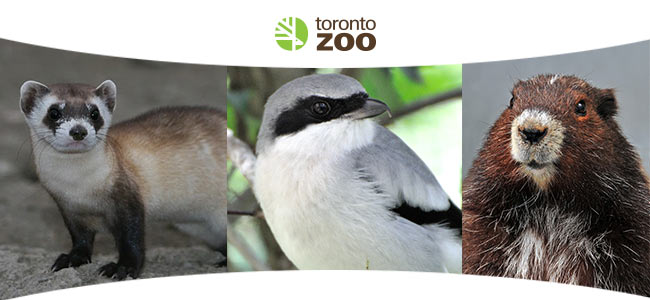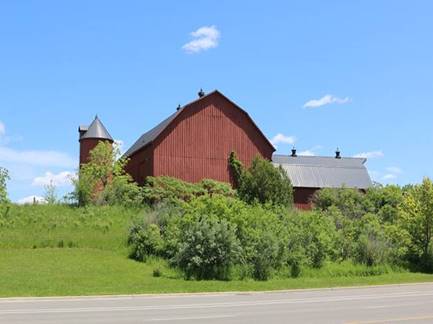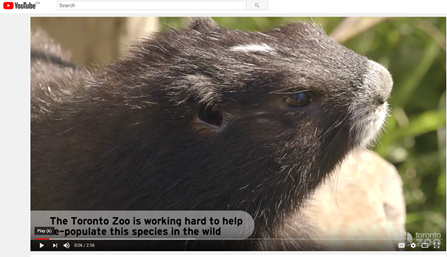
TORONTO ZOO’S ICONIC RED BARN AND SURROUNDING BUILDINGS SERVE AS SPECIALIZED CONSERVATION BREEDING FACILITIES FOR THREE ENDANGERED CANADIAN SPECIES

Iconic Red Barn and Buildings Along Meadowvale Road, Photo Credit: Toronto Zoo
To watch the video about the conservation programs in the red barn click here:

TORONTO, ON, July 25, 2019: The Toronto Zoo has a long and proud history of saving and protecting species at home and abroad. Many people who’ve travelled along Meadowvale Road have seen the very distinctive red barn on the east side, but likely don’t know the significance that surrounds it. This particular building, and two other smaller structures that are set back within the tree line along Meadowvale Road, are one of only a handful of specialized conservation breeding centres in Canada for three endangered species; black-footed ferret (BFF), eastern loggerhead shrike (ELS) and Canada’s most endangered mammal, the Vancouver Island marmot (VIM).
The Toronto Zoo has been part of the BFF conservation breeding program as an endangered Canadian species since 1992. Hundreds of babies, also referred to as kits, have been bred for reintroduction to the wild in USA, Mexico, and Canada, where the ferret was listed as extirpated in 1978. This conservation breeding program has helped re-establish this species back into the prairies and has increased the wild population to approximately 300 animals. The BFF conservation breeding program continues to be important as the ferrets continue to face threats, such as habitat loss and disease.
In 1997, Toronto Zoo began taking part in the conservation breeding program for the VIM, which is one of the most critically endangered animals in the world and Canada’s most endangered mammal. This species had only 30 individuals left in the wild in 2003, but the population is now estimated to be between 200-300, thanks to joint efforts from four Canadian facilities. Research and recovery efforts continue to protect the marmot and its habitat in Vancouver.
At the Toronto Zoo, breeding pairs of marmots are kept out of the public eye in the specialized breeding centre and have minimal human-animal contact to keep the animals’ conditions as natural as possible. Our marmots are provided with specialized diets and multiple enclosures, which are furnished to allow for natural behaviours such as nesting, digging, gnawing and watching for predators. Breeding takes place shortly after the marmots awake from hibernation in March or April, and gestation lasts only 30 days, though not every pair breeds every year. Baby marmots, called pups, usually come in litters of three to four animals and remain hidden in the nests made by their parents in sheltered nest boxes for the first few weeks of their lives. Specially trained Wildlife Care Keepers rely on hearing the squeaks the marmots make to communicate with their mothers’ to signal which pairs have successfully bred. Often the pups are nearly a month old before they begin exploring beyond their nest boxes where the keepers can see them. The pups grow quickly throughout the summer and by the fall are independent enough to be sent to Vancouver Island where they make the final preparations for their first over-winter hibernation and eventual release into the wild.
And finally, the eastern subspecies of the loggerhead shrike is one of the most imperiled birds in North America. In Canada, loggerhead shrikes are now only found in a few isolated pockets of grasslands in Ontario, Quebec, and Manitoba. They used to be found readily from southwestern Manitoba, east to the Maritime Provinces.
In 1991, in response to a rapidly declining population, the Committee on the Status of Wildlife in Canada (COSEWIC) listed the eastern loggerhead shrike as endangered, and it is now protected by provincial endangered species legislation in Ontario, Manitoba, and Quebec. In 1992, a Loggerhead Shrike Recovery Team was formed and recovery plans were produced by 1994. In 1997, when only 100 eastern loggerhead shrikes were estimated to remain in all of Canada and a mere 18 pairs could be found in Ontario, Environment Canada established a captive population to ensure that the unique genetic material of these birds would be preserved. Between 1997 and 1998, 43 young birds were brought into captivity and the first captive breeding followed shortly thereafter. The Toronto Zoo has been involved in the captive breeding of the ELS since the program’s inception and have hatched well over 100 chicks.
“The Toronto Zoo plays a critical role as one of only a few conservation breeding centres for many endangered species in Canada. Our ability to contribute to these increased populations of black-footed ferrets, Vancouver Island marmots and eastern loggerhead shrikes is only because of our highly trained professional staff who monitor and manage these populations and the unique facilities that house these programs” said Mr. Dolf DeJong, Chief Executive Officer, Toronto Zoo. “With recent reports of the decline of a number of Canadian species, it is our hope that we can expand our capabilities in order to work with more partners to sustain the populations of endangered and species at risk for future generations,” he added.
The Toronto Zoo works with many different partners, including Parks Canada, on species recovery and breeding programs and we look forward to strengthening this partnership with the establishment of the new Rouge National Urban Park.
-30-
To learn more about Toronto Zoo’s projects to support Canadian species:
Toronto Zoo Media Contacts:
Katie Gray, Manager of Strategic Communications
[email protected] or #416-392-5941
About The Toronto Zoo
The Toronto Zoo is Canada’s premier zoo and a national leader in saving wildlife to ensure the rich diversity of nature for future generations. More than a tourist attraction, the Toronto Zoo boasts a number of leading programs for helping wildlife and their natural habitats – from species reintroduction to reproductive research. A world-class educational centre for people of all ages, the Toronto Zoo is open every day except December 25 and attracts approximately 1.3 million visitors each year.

